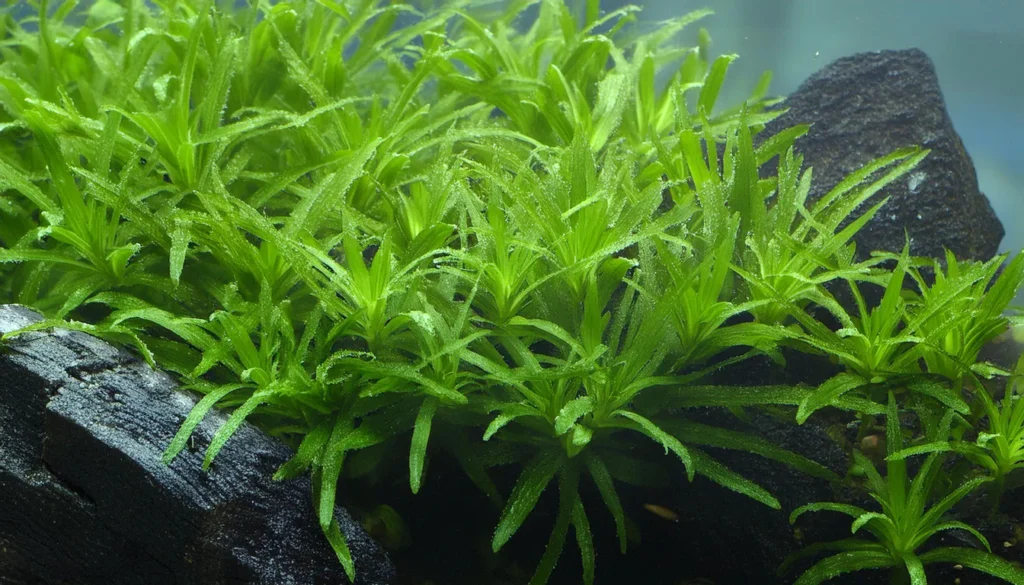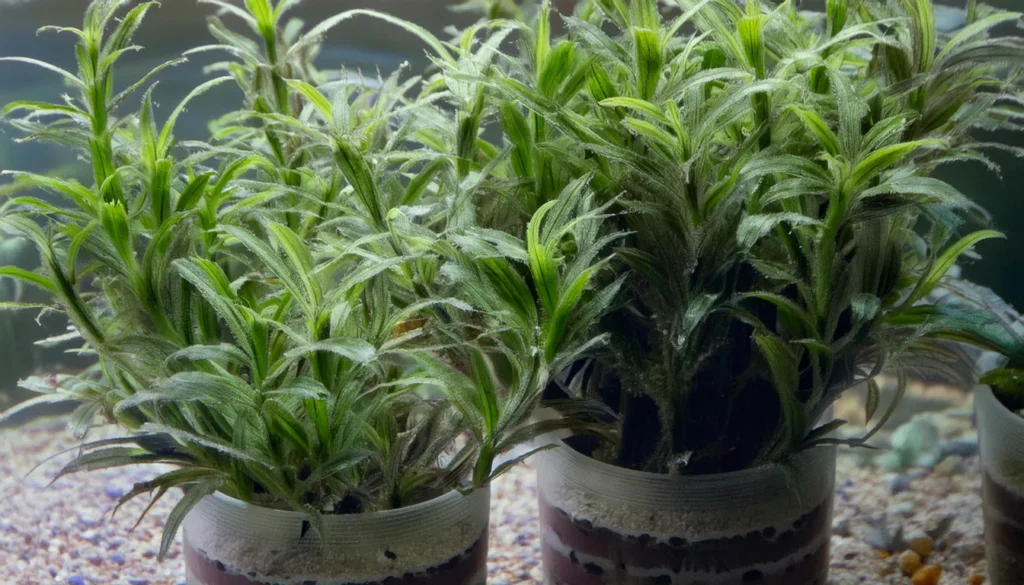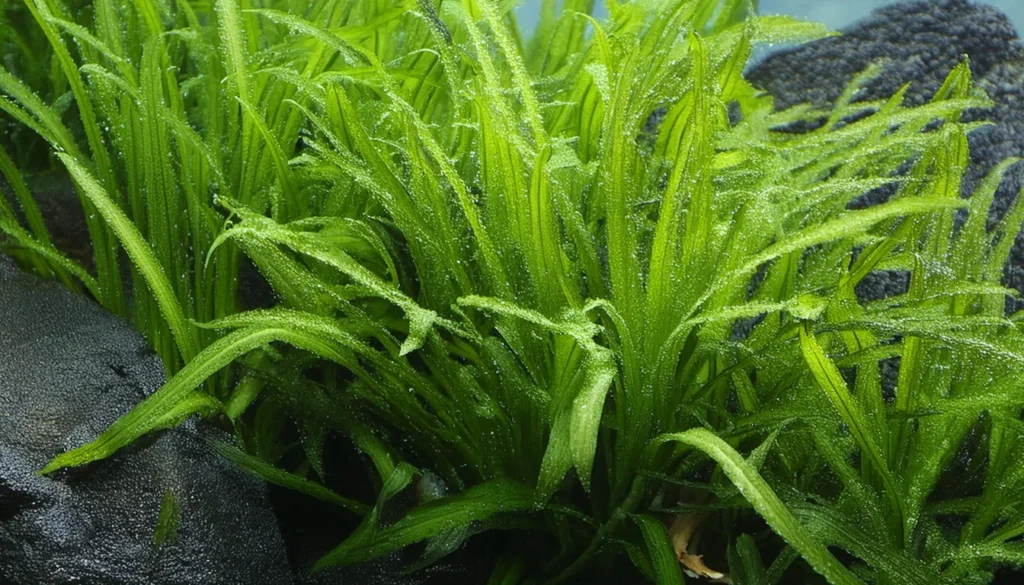As an avid aquarium enthusiast, I am always on the lookout for unique and captivating aquatic plants to enhance the beauty of my freshwater aquarium.
Recently, I discovered an aquatic plant that truly stole the spotlight in my underwater paradise – Heteranthera Zosterifolia, also known as Stargrass.
Heteranthera Zosterifolia is a stunning aquatic species native to Brazil, known for its sharp and spikey leaf formations that resemble starlight.
Its lush growth and distinctive visual appeal make it a must-have for any aquarist looking to create a mesmerizing aquatic habitat.
In this article, I will delve into the origins and characteristics of Heteranthera Zosterifolia, as well as provide you with essential plant care tips and planting instructions to ensure its optimal growth in your freshwater aquarium. Let’s uncover the secrets of this starry aquatic beauty.

Key Takeaway
- Heteranthera Zosterifolia, also known as Stargrass, is a captivating aquatic plant.
- Its sharp and spikey leaf formations resemble starlight, adding visual appeal to aquatic gardens.
- Native to Brazil, Heteranthera Zosterifolia thrives in freshwater aquariums.
- Proper plant care, including lighting, pruning, and propagation, is crucial for its lush growth.
- Creating an ideal aquatic habitat with suitable pH and CO2 levels is essential for sustaining this beautiful plant.
Quick Stats
| Attribute | Details |
| Family Name | Pontederiaceae |
| Origin | South America |
| Height | 20-50 cm (8-20 inches) |
| pH Range | 6.0 – 7.5 |
| CO2 Requirement | Moderate to High |
| Growth Rate | Fast |
| Care Level | Easy to Moderate |
| Color Form | Bright Green |
| Water Conditions | 20-28°C (68-82°F), adaptable to a wide range of hardness |
| Max Size | Stems can grow up to 50 cm (20 inches), but can be trimmed to desired height |
| Lighting | Moderate to High |
| Supplements | CO2 supplementation and comprehensive liquid fertilizer |
| Placement | Mid-ground to Background |
| Propagation | Stem cuttings |
What Is Heteranthera Zosterifolia?
Heteranthera Zosterifolia, also known as Stargrass, is a freshwater aquatic plant that adds a touch of natural beauty to any aquarium.
This captivating plant is native to marshes and wetland areas in South America, particularly Brazil.
Belonging to the Pontederiaceae family, Heteranthera Zosterifolia is renowned for its distinctive growth patterns and striking visual appeal.
Natural Habitat And Origins
Heteranthera Zosterifolia thrives in the natural habitat of marshes and wetlands, where it flourishes in the underwater environment.
Its roots anchor it to the substrate, allowing it to absorb nutrients and thrive in these ecosystems’ rich organic matter.
The plant’s ability to adapt to varying water conditions makes it an ideal choice for freshwater aquariums.

Characteristics And Visual Appeal
- One of the most captivating aspects of Heteranthera Zosterifolia is its unique visual appeal. The plant features sharp and spikey leaves resembling starlight twinkling in aquatic gardens.
- The lush green foliage creates an eye-catching contrast against the crystal-clear water of the aquarium, adding depth and dimension to underwater landscapes.
- With its versatility, Heteranthera Zosterifolia can be used in various aquascaping designs. Whether arranged as a focal point or planted in groups, this aquatic plant injects vibrant color and texture into any freshwater aquarium.
- Its distinctive growth patterns create an enchanting visual spectacle, making it a favorite among aquarists and plant enthusiasts.
Lighting Requirements For Optimal Growth
- When planting Heteranthera Zosterifolia, it is crucial to consider its lighting requirements for achieving optimal growth. This aquatic plant thrives in moderate to high light levels, making it essential to provide sufficient illumination in your aquarium. Brighter light promotes bushy growth, while moderate light allows for looser, upward growth.
- Consider using aquatic plant-specific LED lights or fluorescent lights with a color temperature of around 6500K to mimic natural sunlight.
- Ensure that the light intensity and duration are appropriate for the needs of Heteranthera Zosterifolia to avoid stunted growth or algae issues.
Temperature Needs For Robust Growth
To achieve robust growth of Heteranthera zosterifolia (stargrass), maintain water temperatures between 22°C to 28°C (72°F to 82°F).
This temperature range replicates its natural tropical habitat and supports optimal growth, metabolism, and nutrient absorption.
Consistency in temperature is crucial for stargrass, so avoid rapid fluctuations to prevent stress and promote vigorous growth.
Heteranthera Zosterifolia
Optimal Water Condition
- Temperature: Keep the water temperature in the range of 22°C to 28°C (72°F to 82°F) to mimic its natural tropical habitat.
- pH Level: Stargrass thrives in slightly acidic to neutral water conditions with a pH range of 6.5 to 7.5.
- Water Hardness: It prefers moderate water hardness, with a general range of 2 to 15 dGH (German degrees of hardness).
- Lighting: Provide moderate to high lighting levels, as stargrass requires ample light for photosynthesis and growth.
- Nutrient Levels: Ensure that essential nutrients, including nitrogen, phosphorus, potassium, and micronutrients, are available in the water column and substrate. Consider supplementing with liquid fertilizers or root tabs to meet the plant’s nutritional requirements.
- CO2: While not mandatory, providing supplemental CO2 can enhance growth and promote vibrant coloration in stargrass. CO2 supplementation can be achieved through injection systems or liquid carbon supplements.
- Water Circulation: Maintain adequate water circulation to prevent stagnant areas and ensure nutrient distribution throughout the aquarium.
RELATED: Grow Cryptocoryne Lutea For Vibrant Aquariums With This Simple Guide
Substrate Requirement
- Nutrient-Rich Substrate: Choose a substrate specifically designed for planted aquariums, such as aquasoil or nutrient-enriched gravel. These substrates contain essential nutrients like nitrogen, phosphorus, and potassium, which are vital for plant growth.
- Fine Texture: Opt for a substrate with a fine texture, such as sand or fine gravel. A fine substrate allows stargrass roots to anchor securely and spread easily, facilitating growth and nutrient uptake.
- Depth: Provide a substrate depth of at least 2 to 3 inches (5 to 7.5 cm) to allow ample room for root penetration and stability. A deeper substrate layer provides a reservoir for nutrients and promotes healthy root development.
- Iron Content: Ensure that the substrate contains sufficient iron, as it is essential for stargrass’s vibrant green coloration and overall health. Iron-rich substrates or substrate additives can help meet this requirement.
- pH Buffering: Choose a substrate that helps maintain stable pH levels within the desired range for stargrass (around 6.5 to 7.5). pH-buffering substrates can help stabilize water parameters and prevent pH fluctuations that may stress the plants.
Placement Option
- Background Planting: Stargrass can be placed along the back or sides of the aquarium to create a lush green background. Plant taller specimens towards the rear corners to create a sense of depth and perspective in the tank.
- Midground Accent: Use stargrass as a midground accent to add vertical interest and texture to the aquascape. Plant it in groups or clusters amidst lower-growing foreground plants to create contrast and focal points.
- Island Planting: Create islands of stargrass in the center or midsection of the aquarium for a striking focal point. Arrange the plants in dense clusters or drifts to simulate natural stands of vegetation.
- Foregound Highlight: While less common, stargrass can be used in the foreground of the aquarium to add height and visual interest. Plant it in smaller groups or individual stems along the front edge of the tank to create a dynamic transition between the foreground and midground.

Recommended Tank Size
- Nano to Medium Tanks: Stargrass can thrive in smaller tanks ranging from 10 gallons (38 liters) to medium-sized tanks around 50 gallons (190 liters). In smaller tanks, stargrass can be planted along the back or sides to create a lush background or used as a midground accent.
- Large Tanks: In larger tanks exceeding 50 gallons (190 liters), stargrass can be planted more liberally to create dense stands or clusters. Its vibrant green foliage adds depth and texture to larger aquascapes, making it an excellent choice for creating natural-looking backgrounds or focal points.
- Aquascaping Goals: Consider your aquascaping goals and the overall layout of the tank when determining the appropriate tank size for stargrass. Factor in the space available for planting, the desired visual impact, and the compatibility with other aquatic plants and hardscape elements.
- Lighting and CO2: Keep in mind that stargrass typically thrives in moderate to high lighting conditions and benefits from CO2 supplementation. Ensure that your tank size can accommodate the lighting and CO2 requirements necessary to support healthy growth and vibrant coloration.
Pairing With Other Aquatic Species For Visual Harmony
- Another way to enhance the aesthetic appeal of your aquascape is to pair Heteranthera Zosterifolia with other compatible aquatic species. Its lush green foliage provides a perfect backdrop for vibrantly colored fish or contrasting plants.
- Consider incorporating species with different leaf shapes, colors, or textures to create a sense of harmony and balance within the aquarium.
- When selecting companion species, ensure they have similar water and lighting requirements to ensure their compatibility and health. You can create a visually stunning and well-balanced aquarium by carefully planning and selecting aquatic species that complement Heteranthera Zosterifolia.
- Aquascaping with Heteranthera Zosterifolia offers endless design possibilities and the opportunity to create a captivating underwater landscape. Whether you aim for a serene and minimalist layout or a vibrant and lush environment, Heteranthera Zosterifolia can be a valuable addition to your aquascape, adding beauty, depth, and visual interest to your freshwater aquarium.

Nutritional Needs Of The Plants
Heteranthera zosterifolia (stargrass) requires a balanced supply of essential nutrients to support healthy growth and vibrant coloration. Here are the nutritional needs of the plant:
Macronutrients
- Nitrogen (N): Essential for protein synthesis, leaf growth, and overall plant vigor.
- Phosphorus (P): Important for root development, energy transfer, and flower formation.
- Potassium (K): Required for enzyme activation, osmoregulation, and overall plant health.
Micronutrients
- Iron (Fe): Crucial for chlorophyll synthesis, photosynthesis, and vibrant green coloration.
- Magnesium (Mg): Essential component of chlorophyll molecules and enzyme activation.
- Calcium (Ca): Important for cell wall structure, membrane integrity, and nutrient uptake.
- Sulfur (S): Necessary for protein synthesis, enzyme function, and overall plant health.
- Manganese (Mn): Required for photosynthesis, enzyme activation, and nutrient uptake.
- Zinc (Zn): Essential for enzyme activation, hormone regulation, and carbohydrate metabolism.
- Boron (B): Important for cell wall formation, pollen germination, and fruit development.
- Copper (Cu): Necessary for enzyme activation, photosynthesis, and plant metabolism.
- Molybdenum (Mo): Vital for nitrogen metabolism, enzyme function, and overall plant health.
Heteranthera Zosterifolia Cultivation Tips
- Lighting: Provide moderate to high-intensity lighting. Stargrass thrives under bright light conditions, so use LED fixtures or fluorescent tubes to ensure sufficient illumination. Aim for a lighting duration of 8 to 10 hours per day to simulate natural daylight cycles.
- Carbon Dioxide (CO2): Consider supplementing with CO2 to promote robust growth and vibrant coloration. CO2 injection systems or liquid carbon supplements can help maintain adequate CO2 levels in the water, supporting photosynthesis and plant metabolism.
- Nutrient-Rich Substrate: Plant stargrass in a nutrient-rich substrate to provide essential nutrients for healthy growth. Use aquarium soil, nutrient-enriched gravel, or substrate additives to ensure an adequate supply of nitrogen, phosphorus, potassium, and micronutrients.
- Fertilization: Supplement with liquid fertilizers or root tabs to provide additional nutrients as needed. Regularly monitor nutrient levels and adjust fertilization accordingly to prevent deficiencies or excesses. Follow the recommended dosage instructions provided by the fertilizer manufacturer.
- Water Parameters: Maintain stable water parameters within the recommended range for stargrass, including temperature, pH, hardness, and ammonia/nitrite levels. Perform regular water changes to remove accumulated waste and maintain water quality.

Plant Propagation Tips
- Stem Cuttings: Select robust stems with healthy foliage. Using clean, sharp scissors, cut the stem into sections around 2 to 4 inches (5 to 10 cm) long. Remove the lower leaves from the stem cutting to expose a clean section for planting. Plant the cutting in the substrate, burying at least one node (where the leaves were attached) to encourage root development. Ensure the substrate is nutrient-rich to support rapid rooting and growth.
- Lateral Runners: Stargrass naturally produces lateral runners that can develop roots and form new plants. Encourage lateral growth by providing optimal growing conditions, including moderate to high lighting, CO2 supplementation (if available), and nutrient-rich substrate. Once the lateral runners have developed roots and new growth, carefully separate them from the parent plant using sharp scissors or aquascaping tools. Replant the rooted runners in desired areas of the aquarium, ensuring they have enough space to grow without overcrowding.
- Pruning and Maintenance: Regularly prune and thin out stargrass to promote branching and lateral growth. Trim excess growth using sharp scissors to prevent shading and encourage healthy propagation. Monitor the density of the stargrass carpet and thin out overcrowded areas to maintain optimal growth conditions for all plants. Additionally, remove any decaying or dead plant material to prevent nutrient imbalances and maintain water quality.
- Rooting Hormones (Optional): Consider using rooting hormones to promote faster root development and increase the success rate of stem cuttings. Dip the cut end of the stem cutting into a rooting hormone powder or gel before planting it in the substrate. While not essential, rooting hormones can expedite the rooting process, especially in plants that are slow to establish roots.
Benefits Of Planting Heteranthera Zosterifolia
- Natural Aesthetic: Stargrass adds a lush and vibrant green color to your aquarium, enhancing its visual appeal and creating a natural, forest-like environment for your aquatic inhabitants.
- Oxygenation: Like all aquatic plants, stargrass contributes to oxygenation by absorbing carbon dioxide and releasing oxygen during photosynthesis. This helps maintain healthy oxygen levels for fish and other aquatic organisms.
- Water Filtration: Stargrass helps to improve water quality by absorbing excess nutrients such as nitrates and phosphates, which can lead to algae growth if left unchecked. By reducing nutrient levels, stargrass contributes to a cleaner and healthier aquatic environment.
- Habitat and Shelter: Stargrass provides shelter and hiding places for fish, shrimp, and other small aquatic creatures. Its dense foliage offers protection from predators and reduces stress for shy or vulnerable species.
- Natural Algae Control: A healthy population of stargrass can outcompete algae for nutrients and light, helping to prevent the growth of nuisance algae species. By maintaining a balanced ecosystem, stargrass contributes to natural algae control in the aquarium.
- Erosion Prevention: Stargrass helps stabilize the substrate and prevent erosion in aquariums with sloped or uneven terrain. Its extensive root system holds the substrate in place, reducing the risk of soil displacement and maintaining the integrity of the aquascape.

RELATED: Embracing Didiplis Diandra’s Scarlet Serenade In Your Aquascape
Conclusion
Heteranthera Zosterifolia, commonly known as Stargrass, is a captivating aquatic plant that adds a unique touch to any aquatic garden.
With its sharp and spikey leaves, it brings an element of starlight to freshwater aquariums, creating a visually stunning underwater landscape.
By understanding the natural habitat and botanical profile of Heteranthera Zosterifolia, as well as implementing proper plant care essentials, you can cultivate its lush growth and enhance the aesthetic appeal of your aquatic habitat.
Providing the right lighting conditions, employing pruning techniques for dense and healthy foliage, and utilizing propagation methods will contribute to the longevity and vitality of this aquatic plant.
With its adaptability to different lighting levels and versatile growth patterns, Heteranthera Zosterifolia can be effectively used in aquascaping to shape the underwater landscape.
By carefully arranging and pairing it with other aquatic species, you can create a harmonious and natural-looking aquatic environment, adding depth and visual harmony to your freshwater aquarium.
Frequently Asked Questions
What Are The Planting Instructions For Heteranthera Zosterifolia?
When planting Heteranthera Zosterifolia, it is important to consider its lighting requirements and employ pruning techniques for dense and healthy foliage.
Propagation can be done through cutting and subsequent growth by grouping several stems and burying them in the substrate.
How Can I Sustain Heteranthera Zosterifolia In My Aquarium?
Sustaining Heteranthera Zosterifolia involves creating and maintaining suitable aquarium conditions, including monitoring and adjusting pH and CO2 levels to create an ideal aquatic habitat.
What Is The Role Of Heteranthera Zosterifolia In Aquatic Ecosystems?
Heteranthera Zosterifolia plays a vital role in aquatic ecosystems by providing oxygen, absorbing excess nutrients, and offering shelter for aquatic organisms.
How Can I Design Aesthetically With Heteranthera Zosterifolia In Aquascaping?
In aquascaping, Heteranthera Zosterifolia can be shaped to create desired visual effects and paired with other aquatic species to enhance the overall aesthetic appeal of the aquarium.
What Are The Key Points To Know About Heteranthera Zosterifolia?
Heteranthera Zosterifolia is a captivating aquatic plant that uniquely touches aquatic gardens. With its sharp and spikey leaves, it brings an element of starlight to freshwater aquariums.
- Unveiling The Wonders Of Riccia Fluitans In Aquascapes - August 7, 2024
- Vallisneria Gigantea Var. Guide To Care And Cultivation At Home - July 31, 2024
- Vesicularia Dubyana Care & Growth Guide Tips For Beginner Gardeners - July 30, 2024
